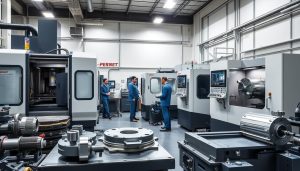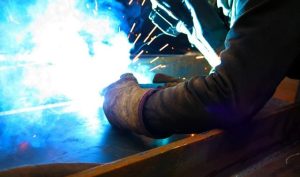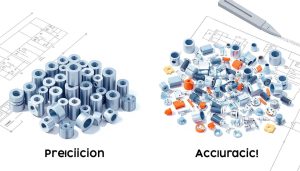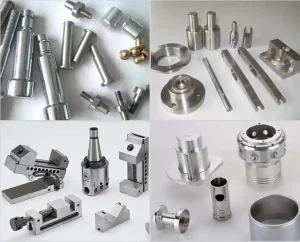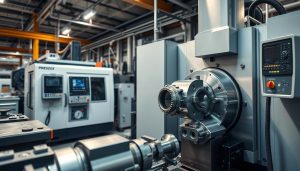In the world of engineering and industrial design, stainless steel is a versatile and indispensable material. Known for its exceptional corrosion resistance, strength, and aesthetic appeal, stainless steel has a wide range of applications, from kitchen appliances to medical equipment. This comprehensive guide delves into the various types of stainless steel, exploring their unique properties and the factors to consider when selecting the right grade for your project.
Key Takeaways
- Stainless steel is a corrosion-resistant alloy with a wide range of industrial and commercial applications.
- There are several different types of stainless steel, each with its own distinct properties and characteristics.
- Understanding the factors that influence stainless steel’s performance, such as corrosion resistance, strength, and cost, is essential when choosing the right grade for your project.
- Consulting with industry experts and comparing materials based on your specific requirements can help you make an informed decision.
- Selecting a reliable supplier, like Shixinproto, is crucial for ensuring the quality and availability of stainless steel products.
What is Stainless Steel?
Stainless steel is a versatile and durable alloy known for its impressive chromium content and rust-resistant properties. Composed primarily of iron, chromium, and other alloying elements, stainless steel’s unique composition sets it apart from standard steel and other rust-resistant metals.
Definition of Stainless Steel
Stainless steel is defined as an iron alloy containing a minimum of 10.5% chromium, which forms a passive, invisible, and highly corrosion-resistant layer on the surface of the metal. This chromium-rich layer protects the underlying iron from oxidation, making stainless steel a highly sought-after material in various industries.
Why is Stainless Steel Important?
Stainless steel’s exceptional corrosion resistance and durability make it an indispensable material in numerous applications. Its ability to withstand harsh environments, high temperatures, and chemical exposure make it a popular choice for industries such as:
- Food and beverage processing
- Pharmaceutical and medical equipment manufacturing
- Architectural and construction projects
- Automotive and aerospace engineering
Additionally, thechromium contentin stainless steel contributes to its strength and hardness, making it a versatile choice for a wide range ofiron alloyapplications where rust-resistant metals are required.
“Stainless steel’s unique properties make it an essential material in countless industries, from the kitchen to the factory floor.”
Different Types of Stainless Steel
Stainless steel is a versatile material with various types, each offering unique properties and applications. In this section, we will explore the four main categories of stainless steel: austenitic, ferritic, martensitic, and duplex.
Austenitic Stainless Steel
Austenitic stainless steels, such as the popular 300 series, are known for their excellent corrosion resistance and formability. They contain high levels of chromium and nickel, which give them their signature non-magnetic properties and superior resistance to pitting and crevice corrosion. Austenitic stainless steels are commonly used in food processing equipment, kitchen appliances, and architectural applications.
Ferritic Stainless Steel
Ferritic stainless steels, including the 400 series, are characterized by their lower chromium content and ferromagnetic properties. These steels are less expensive than austenitic grades and offer good corrosion resistance, making them suitable for applications such as automotive exhaust systems, household appliances, and certain types of hardware.
Martensitic Stainless Steel
Martensitic stainless steels are known for their high strength and hardness, which are achieved through a heat treatment process. These steels contain relatively high carbon content and are often used in cutting tools, surgical instruments, and high-stress applications where increased strength and wear resistance are required.
Duplex Stainless Steel
Duplex stainless steels are a unique blend of austenitic and ferritic stainless steel, offering a combination of high strength, excellent corrosion resistance, and good weldability. This type of stainless steel is often used in the oil and gas industry, marine environments, and certain chemical processing applications where both strength and corrosion resistance are crucial.
Understanding the differences between these stainless steel types is crucial when selecting the right material for your project, as each has its own set of properties and characteristics that make it suitable for specific applications.
“Stainless steel is not just a material; it’s a reflection of our commitment to quality, durability, and innovation.”
| Type of Stainless Steel | Key Properties | Typical Applications |
|---|---|---|
| Austenitic | Excellent corrosion resistance, non-magnetic, highly formable | Food processing equipment, kitchen appliances, architectural applications |
| Ferritic | Good corrosion resistance, ferromagnetic, lower cost | Automotive exhaust systems, household appliances, hardware |
| Martensitic | High strength and hardness, wear-resistant | Cutting tools, surgical instruments, high-stress applications |
| Duplex | High strength, excellent corrosion resistance, good weldability | Oil and gas industry, marine environments, chemical processing |
Key Factors to Consider When Choosing Stainless Steel
When selecting the right stainless steel for your project, there are several critical factors to consider. These include corrosion resistance, strength and hardness, heat resistance, and cost and availability. Understanding these key elements can help you make an informed decision that meets your specific requirements.
Corrosion Resistance
Stainless steel’s ability to resist corrosion is one of its most valuable properties. The grade you choose should have the appropriate pitting resistance and corrosion resistance for your application, whether it’s exposed to harsh chemicals, saltwater, or other corrosive environments.
Strength and Hardness
The tensile strength and hardness of stainless steel are essential factors, especially for applications that require high load-bearing capacity or resistance to wear and tear. Different grades offer varying levels of strength and hardness, so it’s crucial to select the one that best matches your project’s needs.
Heat Resistance
Stainless steel’s thermal conductivity and ability to withstand high temperatures can be critical in applications such as industrial equipment, cooking appliances, or automotive components. Choosing a grade with the appropriate heat resistance is essential to ensure the material’s long-term performance and reliability.
Cost and Availability
Finally, the cost and availability of the stainless steel grade you select can also be important factors. Some grades may be more expensive or harder to source than others, so it’s essential to balance your performance requirements with your budget and supply constraints.
| Factor | Importance | Key Considerations |
|---|---|---|
| Corrosion Resistance | High | Pitting resistance, exposure to chemicals, saltwater, etc. |
| Strength and Hardness | High | Tensile strength, load-bearing capacity, wear resistance |
| Heat Resistance | Moderate | Thermal conductivity, ability to withstand high temperatures |
| Cost and Availability | Moderate | Budget constraints, supply chain considerations |

By carefully evaluating these key factors, you can ensure that the stainless steel you choose for your project meets your specific requirements and delivers the desired performance and value.
How to Choose the Right Stainless Steel for Your Project
Selecting the appropriate stainless steel grade for your project is a critical decision that can have a significant impact on the success and longevity of your endeavor. This process requires a careful consideration of various factors, from understanding your project’s unique requirements to consulting industry experts and comparing materials based on performance and budget.
Understanding Your Project’s Requirements
The first step in choosing the right stainless steel is to thoroughly evaluate the specific needs and demands of your project. Consider factors such as the environment the material will be exposed to, the level of corrosion resistance required, and the structural integrity needed. By clearly defining your project’s specifications, you can narrow down the selection of stainless steel grades that best suit your needs.
Consulting Industry Experts
Navigating the vast landscape of stainless steel options can be a daunting task, which is why it’s essential to consult with industry experts. Reach out to engineering professionals, material scientists, or experienced suppliers who can provide valuable insights and recommendations based on their extensive knowledge and expertise. These experts can help you understand the nuances of different stainless steel types and guide you towards the most suitable choice for your project’s material selection and project specifications.
Comparing Materials Based on Performance and Budget
Once you have a clear understanding of your project’s requirements and have sought expert engineering consultation, it’s time to compare various stainless steel options based on their performance characteristics and cost-effectiveness. Analyze factors such as corrosion resistance, strength, heat tolerance, and availability to determine the best balance between quality and budget. This careful evaluation will help you make an informed decision that aligns with your project’s goals and financial constraints.

By following these steps, you can ensure that you choose the right stainless steel for your project, maximizing its performance, durability, and cost-effectiveness. Remember, the selection of the right material is crucial for the success of your endeavor, so take the time to thoroughly evaluate your options and consult with industry experts.
How to Choose the Right Supplier for Stainless Steel
Selecting the right supplier for your stainless steel needs is crucial for ensuring the quality, reliability, and timely delivery of your projects. When it comes to sourcing stainless steel, considering a supplier’s quality assurance processes, supply chain reliability, and product certifications can make all the difference.
Factors to Consider When Selecting a Supplier
To find a reliable stainless steel supplier, it’s important to assess the following key factors:
- Quality control measures: Ensure the supplier has robust quality assurance processes in place to maintain the highest standards of product quality.
- Delivery times and supply chain reliability: Look for a supplier that can consistently deliver stainless steel products on time, meeting your project deadlines.
- Product certifications and industry accreditations: Prioritize suppliers with relevant product certifications, such as ISO or ASTM, to validate their expertise and commitment to quality.
- Customer service and technical support: Evaluate the supplier’s responsiveness and their ability to provide knowledgeable guidance on product selection and applications.
Why Shixinproto is a Reliable Supplier for Stainless Steel
Shixinproto, a leading manufacturer and supplier of stainless steel products, stands out as a trusted partner for businesses across various industries. With a strong focus on quality assurance, supply chain reliability, and comprehensive product certifications, Shixinproto delivers exceptional value and peace of mind to its customers.
| Strength | Benefit |
|---|---|
| Robust Quality Assurance | Shixinproto’s state-of-the-art quality control processes ensure consistent product quality and compliance with industry standards. |
| Reliable Supply Chain | With a well-developed logistics network and strategic partnerships, Shixinproto guarantees timely delivery of stainless steel products to meet your project deadlines. |
| Comprehensive Certifications | Shixinproto’s stainless steel products are backed by numerous certifications, including ISO, ASTM, and more, providing assurance of their quality and performance. |
By choosing Shixinproto as your stainless steel supplier, you can be confident in the quality, reliability, and timely delivery of your projects, ensuring a smooth and successful outcome.
Conclusion
In our comprehensive guide, we’ve explored the diverse types of stainless steel and their unique characteristics. From the corrosion-resistant austenitic varieties to the high-strength martensitic grades, each type offers distinct advantages catering to various industrial applications.
Summary of Stainless Steel Types
Austenitic stainless steels are known for their excellent corrosion resistance and formability, making them a popular choice for food processing equipment, kitchen appliances, and architectural designs. Ferritic stainless steels provide superior magnetic properties and are often used in automotive exhaust systems and household appliances. Martensitic stainless steels, on the other hand, boast exceptional hardness and wear resistance, finding applications in cutting tools, surgical instruments, and marine hardware. Lastly, duplex stainless steels combine the strengths of austenitic and ferritic varieties, offering a balance of corrosion resistance and mechanical performance for offshore structures, power plants, and chemical processing facilities.
Choosing the Right Material and Supplier
When selecting the appropriate stainless steel for your project, it’s crucial to consider factors such as corrosion resistance, strength, heat tolerance, and cost-effectiveness. By understanding your specific requirements and consulting industry experts, you can make an informed decision that optimizes performance and aligns with your budget. Partnering with a reliable supplier like Shixinproto, known for its commitment to quality and customer service, can further ensure a seamless stainless steel procurement process and successful project outcomes.
FAQ
What is the definition of stainless steel?
Why is stainless steel important?
What are the main types of stainless steel?
- Austenitic stainless steel (300 series)
- Ferritic stainless steel (400 series)
- Martensitic stainless steel
- Duplex stainless steel
Each type has unique properties and is suited for different applications based on factors such as corrosion resistance, strength, and heat resistance.
What factors should I consider when choosing stainless steel?
- Corrosion resistance: Determine the level of resistance needed based on the environment and application.
- Strength and hardness: Consider the mechanical properties required for your specific use case.
- Heat resistance: Evaluate the thermal properties if the material will be exposed to high temperatures.
- Cost and availability: Balance your performance requirements with budget constraints and material accessibility.
How do I choose the right stainless steel for my project?
- Understand your project’s specific requirements, such as performance, environmental conditions, and budget.
- Consult industry experts or engineering professionals to ensure you choose the optimal grade.
- Compare the available stainless steel options based on their performance characteristics and cost-effectiveness.
What should I look for when choosing a stainless steel supplier?
- Quality assurance: Ensure the supplier has robust quality control processes and product certifications.
- Supply chain reliability: Evaluate the supplier’s ability to meet your delivery timelines and maintain consistent product availability.
- Customer service: Look for a supplier who provides responsive and knowledgeable support throughout the purchasing process.
